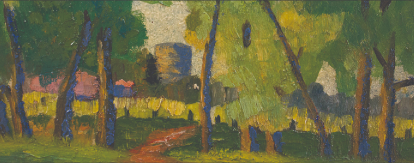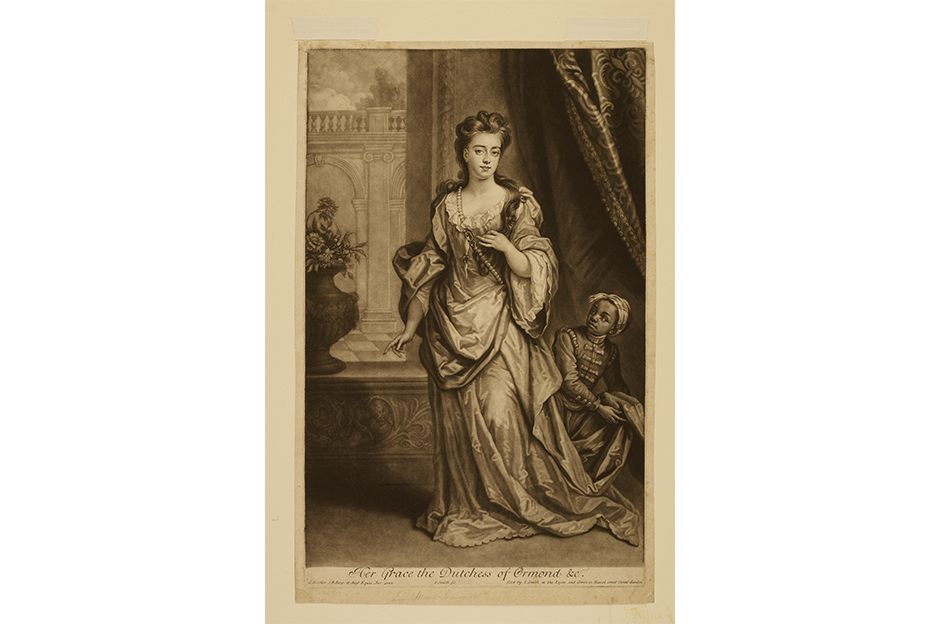The phrase, the dark manner refers to the mezzotint printmaking process developed in Amsterdam in the early 17th century. Prints produced by this process were especially popular in 18th-century England, which is why the process was sometimes referred to also as the English manner.
The word mezzotint is derived from Italian; mezzo, meaning half, and Tinta meaning tone. This printmaking process uses tonal gradations of light and shade, rather than lines, to make an image. Mezzotints are made by working the surface of a plate, usually copper, with a serrated metal tool called a rocker. This roughened surface, when inked, prints uniformly black. The engraver makes an image by selectively burnishing areas of the plate's roughened surface. These smoother sections retain less ink and print as lighter shades of gray.
The prints in this exhibition were all made between ca. 1685 and 1805, a period that is considered the golden age of English mezzotint print production. They are part of a much larger collection of historical etchings, engravings, and lithographs originally assembled by the American industrialist, businessman, lawyer, and diplomat, Owen D. Young (1874-1962), who was born in Herkimer County, N.Y., was president and chairman of General Electric from 1922 to 1939, founder of the National Broadcasting Company in the mid-1920s, and Time magazines Man of the Year in 1930.
Youngs' collection was given to the Museum in 1966 by his descendants. It is one of the largest gifts of artworks ever donated to the Museum. Only the Proctor family 1935 bequest and the collections of American, European, and Asian artworks that Edward Wales Root (1884-1956) gave the Museum during the 1950s were larger. Another important aspect of Youngs' collection is its antiquarian flavor. His enthusiasm for English mezzotints of the 18th and early 19th centuries echoes the anglophile taste of prominent early 20th century American collectors like the industrialist, Henry C. Frick (1849-1919) and railroad magnate, Henry E. Huntington (1850-1927), whose collections are now in museums bearing their names.
Eighteenth-century English mezzotint production was a highly collaborative enterprise involving the efforts of an artist, who was responsible for the original image, an engraver who produced the mezzotint plate and printed it, and a publisher who provided financial support in the expectation he would recoup his investment through the widespread sale of the prints.
Although mezzotint engraving was used for a wide range of subjects, the prints in this exhibition are limited to portraits: royals, aristocrats, authors, scientists, businessmen, actors and actresses, courtesans, children, and fashionable society women. Inscriptions at the bottom of these prints, sometimes accompanied by a coat of arms, identify the person portrayed, as well as provide the name of the artist who made the image, the names of the engraver and publisher, and copyright notices.
Interpretative insights about English mezzotint portraits can be drawn from a close study of the prints using an array of academic disciplines including art history, political and cultural history, biography and genealogy, print connoisseurship, and a knowledge of 18th-century manners and customs. For a modern viewer, the poses and gestures of the sitters may seem affected or self-conscious but, in the 18th century, these attitudes were part of the stock-in-trade that portraitists used to flatter their subjects. Such poses illustrate the century's widely-accepted rules of upper-class decorum, as they were codified in the dancing manuals, etiquette books, and similar advice manuals of the time.
To protect these delicate artworks from the harmful effects of too much exposure to light, prints that have been displayed for a period of time in the exhibition will be removed and replaced with other examples from Owen D. Youngs' collection. This precautionary measure will continue until the exhibition closes at the end of the year.
Paul D. Schweizer, Ph.D.
Museum of Art Director and Chief Curator
Suggesting reading (available in the Institutes library)
Carol Wax, The Mezzotint: History and Technique (New York: Harry N. Abrams, Inc., 1990), 25-86.



